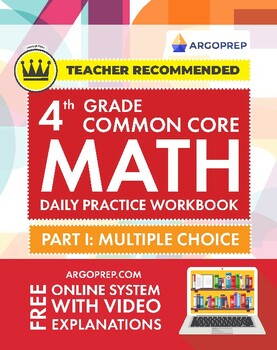4th Grade Daily Practice Math Workbook: (152 pages eBook + video explanations)
- PDF
Description
The 4th grade Daily Practice Math Workbook (Multiple Choice) by ArgoPrep offers teachers and parents a complete workbook covering all topics students need to master at this grade level.
This workbook is aligned with the Next Generation Learning Standards and the Common Core State Standards. This workbook also includes detailed video explanations, which you can access on our website for free after purchase. *(All ArgoPrep workbooks come with detailed video explanations where we go over every question to help all types of learners!)
This eBook includes:
- 20 Weeks of Daily Math Practice focused on Multiple-Choice type questions
- Weekly Challenge Question
- State-Aligned Curriculum
- End-of-Year Assessment
- 600 Practice Questions
- Video Explanations
This book has the following topics covered:
- Week 1 - Place value and comparison symbols
- Week 2 - Rounding numbers
- Week 3 - Division problems
- Week 4 - Multiplication and division problems
- Week 5 - Multi-step word problems
- Week 6 - Patterns and rules
- Week 7 - Fraction comparisons
- Week 8 - Adding and subtraction fractions
- Week 9 - Multiplying fractions by a whole number
- Week 10 - Denominators with 10 or 100
- Week 11 - Comparing decimal numbers
- Week 12 - Measurement units
- Week 13 - Real world word problems
- Week 14 - Tables and charts
- Week 15 - Angles
- Week 16 - Angles (continued)
- Week 17 - Angles (continued)
- Week 18 - Right, acute, and obtuse angles
- Week 19 - Geometric shapes
- Week 20 - Line of symmetry
- End-of-Year Assessment
This workbook is a great resource for teachers to help prepare students for standardized testing, boosting scores and confidence.
ArgoPrep is one of the leading providers of supplemental educational products and has been awarded 15+ educational awards in just the past year. ArgoPrep is used by over 1 million students nationwide.
For any issues or concerns, email us at info@argoprep.com





